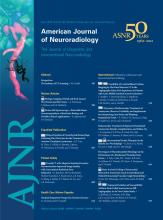We have read with great interest the letter by Dr Kloska1 and a subsequent reply2 concerning a study by Sharma et al,3 investigating the perfusion imaging correlate of CTA source image (CTA-SI) lesions and would like to share our own data on this subject. On the basis of our findings, we agree with Dr Kloska that evaluation of acute ischemia with CTA-SI on state-of-the-art multisection CT scanners depends primarily on the imaging protocol.
In a recent investigation at our institution,4 we analyzed 100 patients with acute ischemic stroke who underwent CTA-SI by using 2 different acquisition protocols with close follow-up DWI. We correlated CTA-SI hypoattenuation volumes with concurrent DWI hyperintense volumes and found that with the older protocol designed for a 4- or 16-section CT scanner (Table), CTA-SI volume correlated well with DWI volume. When a 64-section scanner was installed at our medical center, we modified our CTA acquisition protocol to improve arterial phase opacification (Table), and this was associated with significant overestimation of concurrent DWI volumes. Analysis of the CTA protocol parameters revealed that a shorter time from contrast injection to imaging of the ischemic territory was the single best predictor of CTA-SI overestimation of the infarct core on DWI. Imaging too soon likely prevented the contrast from traversing the collaterals and reaching the infarct bed. Most interesting, atrial fibrillation was associated with CTA-SI overestimation with the older protocol, which used a fixed delay, presumably related to delayed contrast-arrival time from reduced cardiac output.
Overview of CTA protocols used in previous CTA-SI studies of acute stroke
Given these data, we conclude that CTA-SI, just like CT perfusion, requires protocol validation before being used to assess acute infarct size in clinical practice. Moreover, protocol parameters should be standardized. The Table illustrates the variable parameters that have been used in studies evaluating CTA-SI for acute ischemic stroke. Until these issues are fully addressed, CTA-SI should be used cautiously to inform treatment decisions in patients with acute ischemic stroke.
References
- © 2012 by American Journal of Neuroradiology











